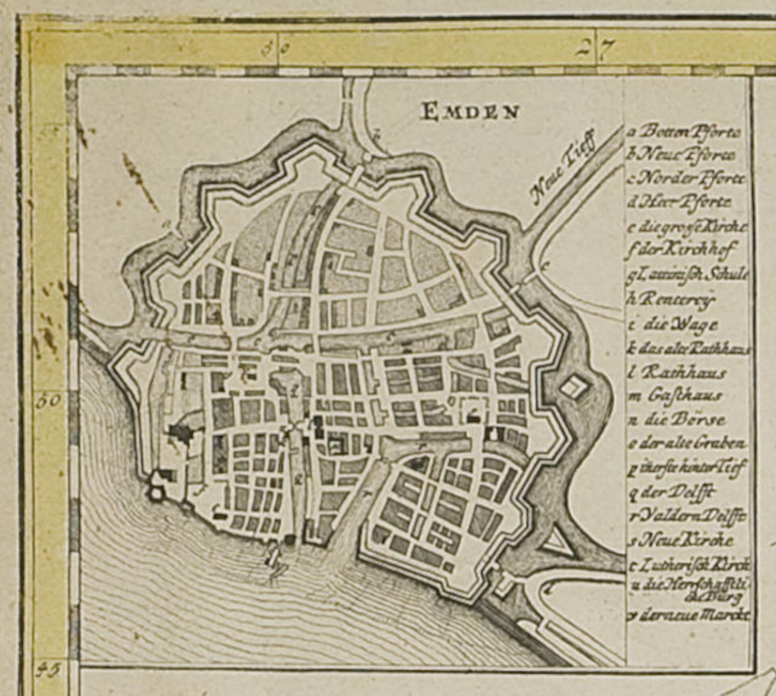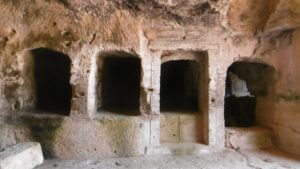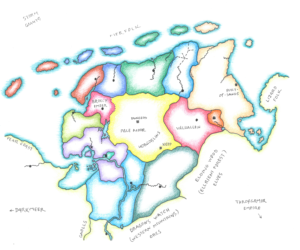I thought to cover the last three steps of the D&D Expert Rulebook’s Designing a Wilderness (X54) in a single article. I try to keep the word count between 400 and 1,000. This one, covering the next step, approaches the limit. So, I cut the remainder again into parts, one article per step, and the “short” series becomes less so.
Reading Map
This is the sixth article of a short-ish series outlining a B/X D&D campaign.
- Atlantis of the Clay
- Warlock of the Pale Moor
- A Forsaken Peninsula
- Thirteen Graves
- Monstrous Denizens of the Pale Moor
- Base Town Emden
- Hekselannen
- Encounters in the Hex Lands
- Beyond the Pale
F. OUTLINE THE BASE TOWN.
Description and Population
Emden is a fortified town. A river borders the south side, and defensive walls enclose the remaining perimeter. Four gatehouses at drawbridges allow entry. Canals divide the town into large quarters and give access to one small port, maybe two. The population is 10,000.
A large town gives PCs access to all the usual resources, while allowing room for growth through their actions. As the campaign progresses, PCs might reduce the monstrous threat from Darkmeer, remove the Pale Moor curse, and extract great wealth from the interior. Population increase follows.

Inset from Tabula Frisiae Orientalis, Ubbo Emmius, 1730.
Government and Defense
The herzog maintains the seat of government in Emden. He resides in a palace (which may well be under construction or recently constructed at campaign start) and keeps a palace guard. In addition, the sovereign may raise an army. While the herzog manages affairs of the duchy,1 an appointed burgrave is charged with the administration of the grave itself, including the town. A town guard maintains order within its precincts. In case of outside threat, the burgrave may call upon the local militia.
Supporting Services
Church
The church holds great sway in the Thirteen Graves. The landgraves need the church’s support to combat the undead and the infernal menace from the Pale Moor. The church takes advantage of the situation to gain secular support to give its edicts the weight of law. A bishop (7th-level cleric) runs the church in Emden and leverages the herzog’s power to establish the church hierarchy throughout the duchy.
Secret #8: The bishop believes the church is much more capable of defending the realm and defeating the infernal hordes. He schemes to take over the duchy and make it a theocracy.
Religious Factions
Here we have an opportunity to come up with some factions within the church that promote a particular doctrine. Here follow three examples:
Crusaders: A knightly order of warriors who battle demons and devils wherever they encroach upon civilized lands. When an infernal horde gathers, the knights petition the bishop to proclaim a crusade, and they lead expeditions into the Pale Moor. Members are clerics, paladins, and fighters, knighted by the herzog.
Inquisitors: A sect that believes witchery is the root of all evil. Their inquisitors search out any practitioners of the black art. Witchery is the practice of witchcraft. In the context of our setting, witchcraft, strictly defined, is any dealing with a devil or demon. Therefore, warlocks and witches are the primary target. But sometimes the sect’s definition of witchcraft may become overly broad.2
Undead Slayers: A band of clerics that recruits warriors to destroy the abomination that is the walking dead. The band is known to make daring raids into the Pale Moor.
The Ghouling Gauntlet
Given the opportunity to reuse—or in this case pre-use—an already created element, we take it. The Ghouling Gauntlet is an ancient order of undead slayers that appears at the end of Wyrm Dawn and the beginning of Wyrmwyrd, thousands of years in our current setting’s future. Perhaps the order is recently formed in response to the moor wraiths. (See the heading The Ghoul of Tower Mill in Wyrm Dawn’s “Empire of the Undersun.”)
Guilds
Magic-Users: While it accepts members regardless of alignment, the Magic-Users Guild is dominated by lawful members, many with ties to the noble family. It maintains strong relationships with the magic-users guilds of the other lawful graves, often working together to further the herzog’s goals, which its lawful members believe coincide with their own. Chaotic members may join together temporarily to foil the efforts of the lawful group when they interfere with their own objectives.
Thieves: The Guild Master of Emden’s Thieves Guild is a member of Broeckemeer’s ruling clan. Her major ongoing operations include spying on the ducal hierarchy, harassing trade routes in and out of the capital, and political assassinations.
Lodging
Travelers and locals may find accommodation, restoration, and entertainment in a few inns, several boardinghouses, and numerous taverns. Following are examples, lightly sketched.
Gasthaus Herzogs: Situated just outside the palace gates, the herzog’s inn provides luxury quarters and gourmet meals to its wealthy clientele. It is patronized by diplomats, aristocracy, the richest merchants, and the spies who note their comings and goings and pretend not to be listening to their conversations.
Gasthof der Langenruhe or Inn of Long Repose: All sorts of travelers, including merchants, adventurers, and the occasional aristocrat, stay at this inn on the main square. Locals sometimes dine in its private dining hall. Mercenaries and men-at-arms frequent the inn’s public taproom.
Geitenhoef Taverne or the Goat’s Hoof Tavern: The southeast quarter has declined in recent years. Geitenhoef Taverne once catered to more affluent patrons. Now, its regulars are laborers, low-ranking soldiers, and adventurers down on their luck. The Geitenhoef is reputedly a hangout of members of the local Thieves Guild.
Widow Walpurga’s Pension: After her husband died 30 years ago, childless Frau Walpurga—known to everyone as Widow Walpurga or “the Widow”—began renting rooms of her large house. Her reputation is that of a kindly old woman, hard of hearing. One or two lodgers may be permanent residents. The Widow keeps one small room for herself at the top of a spiral staircase in the widow’s watch.
Witch Hunting
The landlady is named after Walpurga Hausmannin of German legend. The historic Frau Hausmannin was a tragic victim of a witch hunt. Our Walpurga may be more malefic.
Secret #9: I leave this candy to the DM. For inspiration, I refer you to the transcript of Hausmannin’s trial: “Judgement on the Witch Walpurga Hausmannin.”
To give context to the trial as well as to the general setting, I recommend Chapter 7 of Carl Sagan’s Demon-Haunted World.3 The chapter gives its title to the book.
1 I find it awkward in speech, but a DM might replace duchy with the German herzogtum.
2 An inquisition scenario might be fun. I’d be careful about letting it dominate the campaign.
3 I recommend Sagan’s book, as a whole, for it gives context to the present real-world situation. Carl Sagan, The Demon-Haunted World: Science as a Candle in the Dark, New York: Ballantine, 1996.


The use of German and Dutch names gives it a nicely exotic feel.
Thanks, Davoid. I’m working on the article for next week that talks about names and naming.
Cool!
I have added an antispam plugin. Checking to see how commenting works…
Pingback: Encounters in the Hex Lands – DONJON LANDS
Pingback: Hekselannen – DONJON LANDS
Pingback: Beyond the Pale – DONJON LANDS